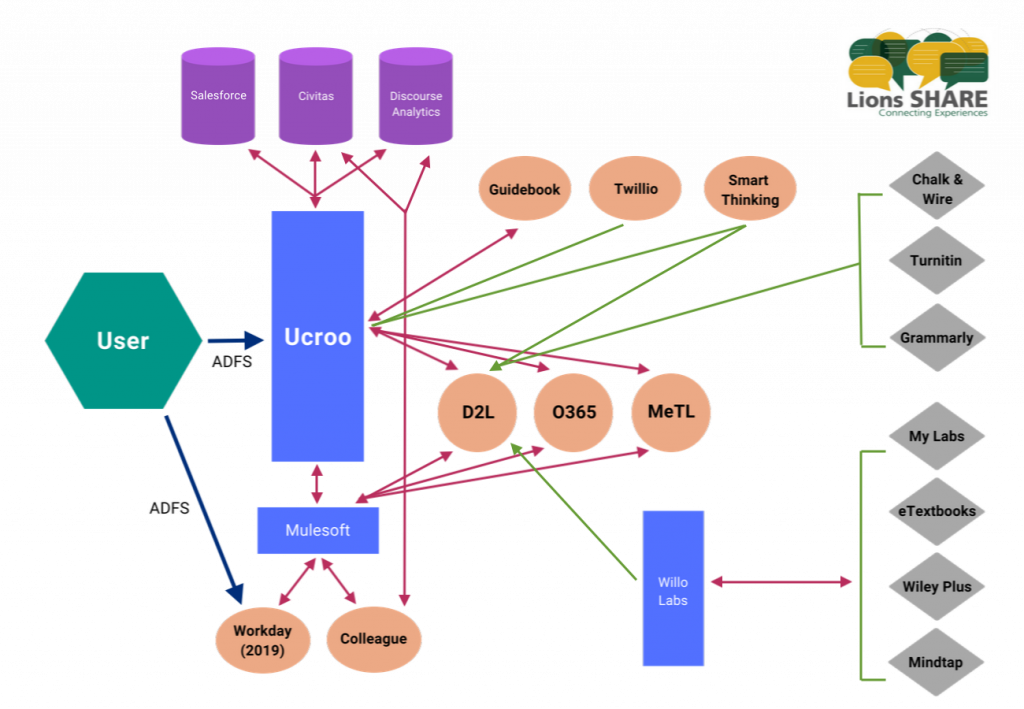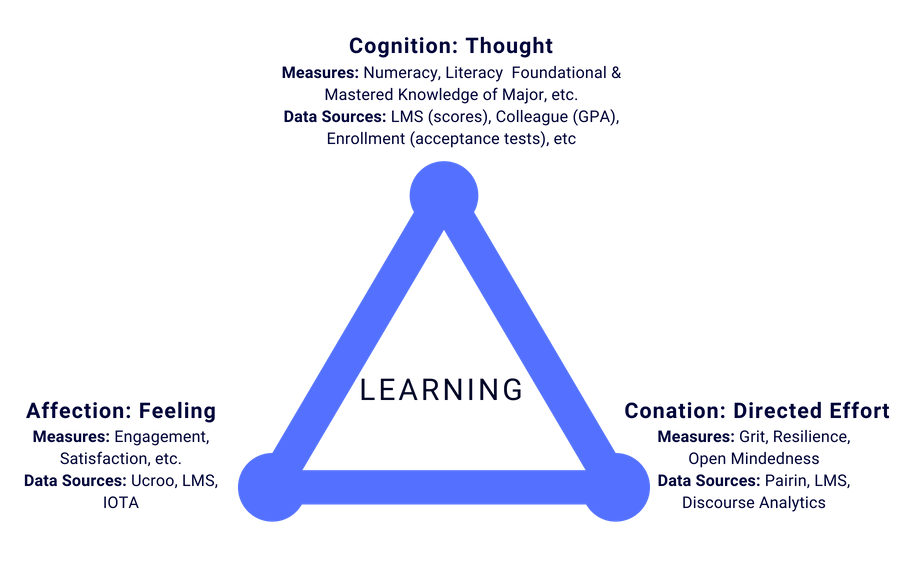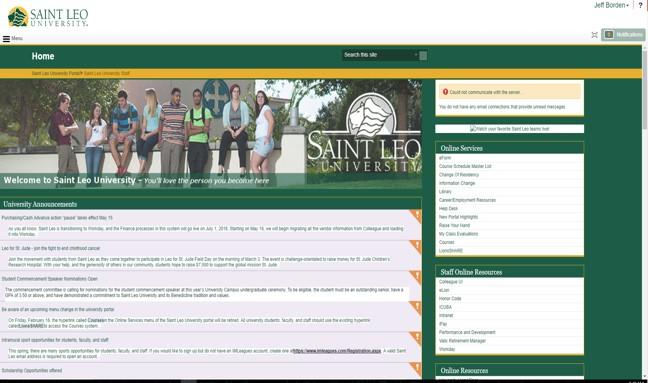
Building a Next Generation Learning System
Saint Leo University
Highlights
18,000+
Enrolled Students
Awards
#26 Regional Universities South
#14 Best College for Veterans
Key Partner
Jeff Borden, Chief Innovation Officer
Office of Teaching and Learning Innovation
Why Pathify
Taking student portals to the next level
The 2017 Horizon Report suggests that all colleges and universities are seeking a, “Next Generation Learning System.” A myriad of reasons underlay this need, but the report goes on to say that, “the overarching goal of next-generation LMS is to shift the focus of these platforms from enabling administrative tasks to deepening the act of learning.” Next-gen systems will do this through advances in highly effective and usable tools, connect-ability between people, artificial intelligence acting as agents, and meaningful data capture as well as usage in both trending (long term) and monitoring (real time). It is also important to note that the Horizon Report theorizes adoption of these systems is two to three years away.

“Pathify enabled us to create not just a portal, which is a very 1990s term, but to create a way for people to get to link-to-link-to-link in a very social way.”
– Jeff Borden, Chief Innovation Officer
On August 15, 2016, Saint Leo University launched Lions SHARE, the basis for a Next Generation Learning System. This system, consisting of 7 “major,” integrated platforms and dozens of “minor” applications set the stage for a SMART, adaptive, artificial intelligence and IoT based experience by which to help students learn more effectively and teachers instruct more efficiently. All of this also includes a vast set of “hooks” by which to perform data analysis both in real time (monitoring) as well as longitudinally (trending).
The primary platform creating the connected nature of Lions SHARE is Pathify (then known as Ucroo Digital Campus). Working with Saint Leo and several other commercial / OER tools and organizations, Pathify tightly knit together the people, resources and experiences that Saint Leo desired for the organization.
Overview
Saint Leo University’s Lions SHARE
Saint Leo University, once a noted pioneer in eLearning, believes they are one of the first institutions of higher education to have assembled and leveraged across the entire enterprise a true Next-Generation Learning System. Labeled “Lions SHARE” (note the apostrophe is missing by design), this learning ecosystem creates an experience for students, faculty and staff that is singular in nature. In other words, when students go from one commercial system to another, they do not realize it as the systems look and feel similar, while acting with interdependence.
At the same time, the five user-facing and four “hidden” tools combine to create some of the most valuable, real-world, highly effective functionalities ever assembled in a learning context. The white-labeled tools known to learners simply as, “SOCIAL (Pathify), COURSES (D2L), WHITEBOARD (MeTL), and PRODUCTIVITY (O365)” are supported behind the scenes by world-class, cloud-based technological infrastructure.
But these tools do not simply give learners the ability to create, share and evaluate better, faster and with more innovation; the system is designed to foster hyper-connectivity. Students can engage in varied degrees of socialness, organizational connectedness and peer-to-peer learning experiences throughout the system. And per the Horizon Report, Lions SHARE is not a shift from streamlining administration to deepening learning; instead the system promotes both to their maximum potential as both attributes are essential.
Likewise, the data collected and leveraged for artificial intelligence is not simply gathering what is easy to find, but what is meaningful to use. Far beyond grades, attendance and end-of-course surveys, Lions SHARE gathers and uses information about behaviors, aptitudes and disposition. This world-class system incorporates demographics, psychographics, satisfaction, personality and real-time behavioral analytics to promote better learning experiences as well as driving efficiency and success.
Lions SHARE is a Next-Generation Learning Ecosystem that is ever expanding, iterating and driving learning at Saint Leo University in ways never before seen in higher education. Importantly, the key platform connecting people, process and programming is Pathify.
The Original Problem
Saint Leo saw several years of overwhelming growth due to the early adoption of online learning as a major, strategic initiative. However, by 2014, most peer and non-peer schools alike had adopted eLearning as a strategy. As a result, Saint Leo knew they were coming into a season of reduced enrollments. This created a need for greater focus on retention and persistence strategies, at least by some at the school.
As a result, the exiting President brought in a Chief Innovation Officer to better address risk and success profiles, cross-departmental retention strategies, and analytics that would illuminate both problems and symptoms. The Chief Innovation Officer identified one key area as a potential way to facilitate massive aid and support to retention efforts in the form of an institutional platform for both learning and risk / success support.
“Integration is what Pathify has really supplied us with, integrating with our LMS, SIS/ERP, with Salesforce. We have got a tightly knit, integrated system. And we’ve actually been able to take that and infuse it into our data set to start to see if students are engaged with the university.”
– Jeff Borden, Chief Innovation Officer
Finding a Solution
Solution Architecture

Saint Leo desired a muti-tenet, omni-directional, single (perceived) user experience. The experience needed to tie together experiences, intervention points, and data around the three corners of the “Learning Triangle.” As often as possible, the tools needed to leverage API technology (allowing for far superior, richer, more holistic user data), with LTI being used as a second (less desirable) choice. Integration work would be performed by Saint Leo as possible (University Technology Services) who employ a staff which includes 4 programmers, but much of the integration work would be performed by each partner and potentially by a strategic initiative budget won by Amazon AWS.

Solution
Saint Leo University wanted to apply strong, replicated research regarding engagement, affinity and mindset from researchers such as Dweck, Medina, McGonigal and many more. This application would marry the strong cognitive work higher ed has pushed from the start of the University as we know it, adding in now-understood and extremely important concepts such as connection and mindfulness to improve major initiatives at the school; namely to improve enrollment, retention / persistence and alumni affinity. To do this work as quickly as possible, Saint Leo sought out a solution that would help its people do what they did best, while allowing for new and updated processes to augment with existing work, creating a genuine “experience” for all students, faculty and staff.
Apart from infrastructure, most of which had to be curated separately from the user experience (UX), a primary platform had to be established. This platform would replace an outdated Sharepoint portal which had been built more than a decade earlier, but had no ROI associated, nor was it leveraged by students, faculty or staff meaningfully. The existing conglomeration of links to many tools as well as some efficiencies to email, did contain notification options, however the communication coming from and through the container was not leveraged by users. The following quote from a Saint Leo Program Coordinator explains it best, “The portal does a great job at making things impossible to find and an even better job convincing the university that important messages have been read, when they have not.” The existing portal was not mobile, did not promote or diminish links other than through forced scrolling, contained obvious errors at all times and had no way of engaging users socially.

The office of Teaching and Learning Innovation, directed by the Chief Innovation Officer, brought in Pathify as the solution to all of the previously stated problems and more. Not only would Pathify allow students to grow with the solution, ensuring “touch points” throughout the (literal) entirety of the student lifecycle, but it encouraged community, communication, mobile and web access, promotion of important links or service, notification pass through and API rich integration options. After several months of searching and vetting, Pathify appeared to be uniquely qualified to create such a platform for hyper-connection and was chosen in December of 2015 as the platform.Implementation
Implementation
Teaching and Learning Innovation (TALI) members sought to implement Lions SHARE in a multi-dimensional, holistic fashion. They believed that a pocketed or partial implementation would lead to the trouble many solutions at the University faced — the silo effect. TALI workers were convinced that almost every single solution brought to bear at the university were too narrow in scope, as they impacted only one stream of student type, department or program, and also promoted even deeper silos of data, impact and expertise. So, when anyone at the University found a “better way” or needed to include data or information sets previously unavailable, these silos proved to be prisons of process, programming or positioning, with no easy way to escape. So, TALI sought to push this solution across stakeholder types, across University departments and across all modalities of learning.
One pragmatic example of this was the “pushing” of data to the Student Success platform (Civitas Learning). Stated as simply as possible, Civitas would combine dozens of elements of demographic data (how much parents make or home zip code, etc) and dozens more elements of “cognitive” data (points, scores, grades, submissions, etc) so as to correlate both markers around a predictive score. Our prediction was specific: Will a student enroll next term? However, in a pilot of Social (Pathify) users, we (historically) added “affective” data; that is, data associated with engagement such as social posts, groups joined, groups created, polls answered, etc. Each behavior or activity added “points” to the user’s profile, which were summed to create an index. That index number (per week) was correlated with cognitive and demographic data. The immediate gain was seeing intervention moments 2.2 weeks sooner than without affective data, with a lowering of false positives as well. This caused our Civitas implementation specialist to state Saint Leo had the most robust student risk and success profile the company had ever seen.
User Roles
Students
Apple Inc produced research in the 1990’s and early 2000’s showing that technology takes time to create meaning and relevance. Frankly, it found that transformation from technology is rare prior to four years of usage. Figure 4 exemplifies the arc of transformation:

To this end, the student initiatives would be targeted at new, previously un-oriented students vs. existing, seasoned students, some of whom had already found other pathways to socialness or engagement. In other words, TALI “leaned into” the four year transformation concept, applying training and usage techniques to students who would not know any differently. Lions SHARE (and by proxy, the SOCIAL engagement platform of Pathify) was actively promoted during Freshman / New Student Orientation, in the First Year Experience course and with all enrollment and admissions workshops.
These students did not receive information about the existing portal, with all appropriate links now appearing in Pathify and even promoting links to students based on persona (e.g. Freshmen would see First Year Experience links whereas Seniors would not, etc). With this strategy in place, it would take four years before (effectively) all undergraduate students were actively using Lions SHARE and Pathify (SOCIAL) as the default system of Saint Leo University.
While the platform was available to all, and through grass-roots adoption, did become a highly used system, the rate of usage by Freshman was 97% of users (based on unique login) per week. This rate of usage has not dropped as the system has grown over time, eventually adding another Freshman class and eventually all students. Based on studies of individual technologies from the portal to the LMS, this was 40-42% more consistent usage. But over the natural, four-year transformation, the student body will norm the platform.
While students were trained on the platform, Pathify required very little instruction due to the intuitive nature of the system. Student Ambassadors were also utilized in a people-connection capacity. Three student workers through the TALI office, in addition to one Super Admin, helped connect other students to offices, departments, services and various stakeholders through the use of keyword monitoring (provided as part of the Pathify platform), and through watching the All-Student activity feed.
Individual Group Admins, created during implementation (e.g. the University staff Group Administrator of the Athletic Department or the financial aid office Group Administrator) also leveraged keywords to assist students with questions or issues that had previously been a barrier, such as how to pay a parking ticket or how to find a research librarian, etc. But effectively, the platform resourcing requirements from a Super Admin perspective were quite low. Across TALI it is estimated that aside from the 10 hours per student work (per week) needed to help bolster usage of the system, the platform itself required approximately .25 FTE of two full-time employees. This is based on the need to administer project management, change management and communication management across the main campus, 44 centers and for the 1/3 of students who are fully online.
Faculty
The members of the TALI did not believe a full implementation would be successful without buy-in and (ideally) adoption / usage by faculty. This included full-time faculty who, like most higher education professors, struggle to find time for new technology, nor do they have the disposition for any technology that appears to be used for its own sake. Likewise, this tool was to be inclusive of the large adjunct population. (Saint Leo University had a ratio of 9 adjuncts to 1 full-time faculty, as of 2016.)
So, in addition to some formal training as well as just-in-time assets (largely video), various Groups were created in Pathify to encourage non-student experiences. Despite being a teaching university, Saint Leo faculty have a research component to promotion and tenure. So, a Research group was created, seeing (by some) for the first time, interdisciplinary discussions and presentation of findings. This promotion of departmental and personal research proved a strong “hook” for some. Likewise, a formal “Teach Better” group was made available to instructors.
But likely the most used Group was (is) a natural component of Pathify – the Subject Group. In this area, students and faculty alike can discuss a course (content, process, textbooks, etc.) without the walls of sections. In other words, all Math 110 students along with every professor teaching Math 110 (both full-time and adjunct) can discuss the inner workings of the course. While not used for every course, several departments found this function to act as a strong marketing play, allowing students to talk with professors about courses they had not intended to take, but after healthy conversations decided to.
Staff
The modular nature of the Pathify implementation was helpful as it pertained to staff. There were departments who did not have an executive sponsor (an executive VP) that wanted to spend time or resources on using the platform to dovetail with existing initiatives or processes. So, those modules were either left “off” or simply left to the crowd-sourced nature of students, who would take on the charge of helping other students with whatever that office or department was responsible for.
But for those departments that did participate, leveraging the new modes and channels by which to engage students, the implementation team did everything possible to assist. Using similar techniques to the faculty rollout, formal training as well as just-in-time experiences were created. These were performed face to face (including at center locations), online, via video conferencing, synchronously, asynchronously, etc. Staff (particularly at centers) found the platform to be an excellent way to create walled-garden experience that also allowed for quick communication.
Of note, one group of staff were in the Communications department. Initially skeptical of “yet another system” to manage, they were not interested initially. The TALI office performed an experiment prior to launch. An email was sent to all faculty and staff with a click-thru link which demanded action. The email was of the highest priority (sent from the VPAA) yet saw only 19% of respondents appropriately click. However, after Lions SHARE was up and running (initially with fewer commercial integrations than in the architecture above, using only the LMS, D2L, and Microsoft), a similar message was sent. This message used email with the addition of a “pinned” announcement, plus push notifications (both mobile and web) from the system. This new communication saw a 67% click-thru. Immediately the Communication office began asking for training.
All Stakeholders
Finally, regular “showcase” events were held by the TALI department, illustrating to the various offices and organizations at Saint Leo what projects were being worked on. This included Lions SHARE and also included capabilities and options for usage. When it came to SOCIAL (Pathify), these presentations proved invaluable as there were always new staff who did not know of the power or efficiencies driven by the platform.
This was augmented by two phone surveys conducted by the Student Workers in the TALI organization. Under the guidance of the Director of Innovation, students requested satisfaction data from users at all levels. Notably, the satisfaction rate (on a scale of 1-5) was 4.5, but perhaps the most telling information came in the form of anecdotes. Center (satellite) campus faculty expressed appreciation at finally being able to see pertinent information while also discussing issues with main-campus personnel. Students, including non-traditional, distance students praised the ability to finally “connect” to messages, information and other students, sometimes finding help ranging from common questions to study sessions. And fully online advisors saw the new channels as an avenue to discover information otherwise never shared nor known. One advisor stated, “It’s like we get to sit next to students in a cafeteria and hear their concerns for the first time.”
Overall, the implementation of a connected platform by which to share and showcase pertinent services and departments, and by which to link people appears to have created meaningful attachments between the people of Saint Leo University and the school itself.Issues
Lessons Learned
Issues
Two significant problems caused the implementation of Lions SHARE (in general) as well as SOCIAL (Pathify specifically) to be less than what it could be. To start, the nature of many universities, Saint Leo included, is to be siloed. Senior Vice Presidents and Directors rarely work in an inter-departmental fashion. So, without genuine collaboration between the Vice Presidents or Presidential / CIO / VPAA mandate, the implementation of a silo-bridging tool which might span an entire university is not easy.
The ability to “modularize” the Pathify offering definitely helped implementation as specific groups were never given permission to put resources or time against the platform. However, the irony of silos as a barrier to a silo-busting tool were made apparent in the third year of implementation. In year three, one of the departments created an RFP, seeking a toolset that would do what SOCIAL was already designed to do. The 10-15% of functionality the tool did not have could be customized at a fraction of the cost and with no recurring licensing. However, as the executive sponsor of that particular stream of the University did not know what Pathify was capable of, they sought a second solution. (Luckily, this effort was curtailed and discussions are happening at the writing of this document.)
The second issue was on the implementation team. Leaving the existing portal turned on through year three was likely unnecessary. From a statistical perspective, giving older students the option of using bad technology meant a continued low-usage rate for those platforms and systems. Many students simply bookmarked the few tools they used, never to return to the portal. This meant notifications and messages coming through the portal were never even seen and any new tools added to the portal were of no value to some users. Once the existing portal was removed, analytics like bounce-rate and unique-weekly-users saw a significant uptick. In other words, the team over-valued the issue of change and it was likely to the detriment of the students and the school.
Conclusion
Final Takeaways
A serious look at every Lions SHARE component is part of the project plan, per tool. In the short life-span of the learning ecosystem, some resources are already being sunsetted (or are close to it). However, the adoption of Pathify as the “front door” to the system (in addition to a middleware component) has proved to be powerful. Not only have initial findings shown a correlation to retention and persistence metrics (term-to-term registration), but the capabilities for staff to help students in new, desirable, highly efficient ways has proven quite positive. The addition of the Alumni module (vs. the existing Alumni Group creation) is of great interest to the university.
In 2017, Saint Leo University had a massive blow of bad luck with three major hurricanes impacting not only the main campus, but centers in the Keys, Houston and throughout the Gulf of Mexico. Many of the effected students fled their cities / states and have no intention of returning. As a result, there is an enrollment crisis which is significantly impacting the bottom line of the school. (Although it was quite powerful to be able to communicate with students via multiple channels throughout the storms.) But it is good to know that the infrastructure decisions around Lions SHARE and SOCIAL (Pathify) will help create a more connected, higher persistence experience for students, faculty and staff as we move forward and recover from these natural disasters.